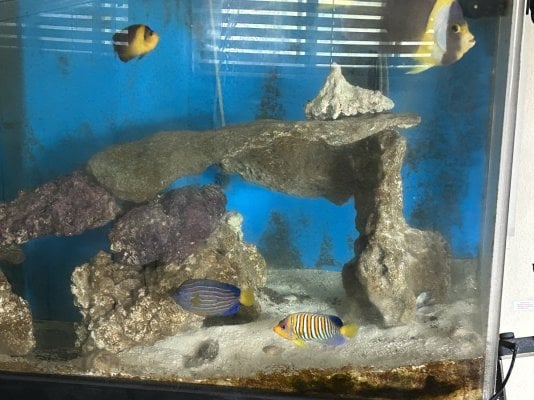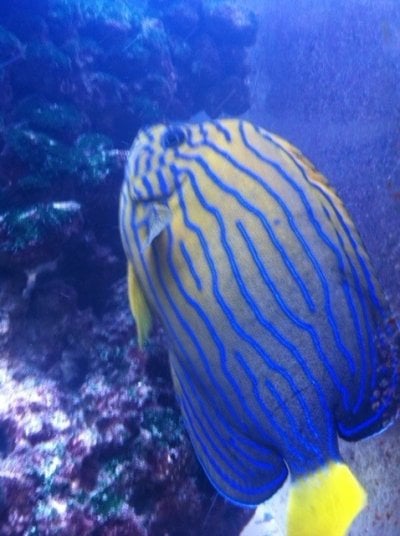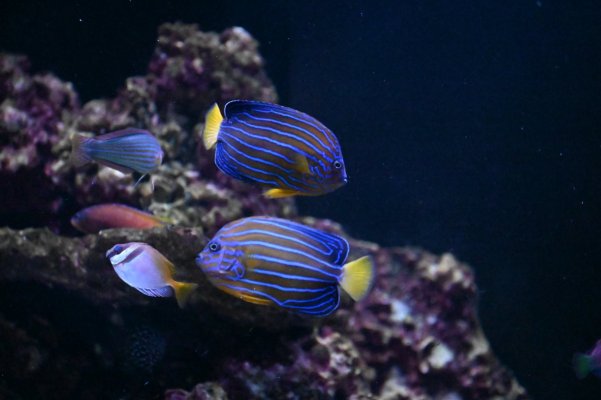The Magnificent Bluestriped Angelfish, Chaetodontoplus septentrionalis
Jay Hemdal
On another note though, large wild caught Bluestriped angelfish are still being collected and sold from Taiwan. These have very little chance of surviving in home aquariums.
Having grown up during the heyday of early marine aquariums in the early 1970’s, I knew that aquarium books often showed pictures of wonderful fish that were simply not available to a young aquarist like me. I was living in the Midwest and resorted to buying fish with my paper route money. One of the fish I recall from that era was the bluestriped angel. I never got any closer to seeing one of those fish (outside of picture books) until over 30 years later when as a public aquarium curator; I noticed a few showing up on dealer’s stock lists. One benefit of working as a curator is that you are given some discretion in the species of animals you can obtain for exhibit. Adding one of these fish to our regular order allowed me access to a species I had only seen before in photographs. Now, a few years later, after working with more of these fish in captivity, I’ve learned a bit about them and want to make sure that anyone else who also follows their dream of acquiring a rare fish like this does not have to relearn what I’ve discovered regarding their care requirements.
The bluestriped angelfish, (also called the bluelined angelfish) has a basic adult color pattern reminiscent of the more commonly seen bluering angelfish, (Pomacanthus annularis). Other than having similar coloration, these fish have quite different care requirements in captivity. The bluering angelfish is more frequently available and is one of the hardiest members of the genus Pomacanthus – either adults or juveniles usually adapt quite well to aquariums. The bluestriped angel is much more rarely seen in the pet trade and adults do not always make the transition into captive life. The coloration of the bluestriped angel is subtly more distinct than that of the bluering angelfish. It is difficult to say exactly what the difference is, and why aquarists seem to prefer the bluestriped angel if given a choice. Both fish have a golden or chestnut brown body color overlain by horizontal blue stripes. It may be that the bluestriped angel’s coloration is a bit more intense, or that because its scales are smaller, the coloration seems crisper. It may also be that simple, yet intangible difference that always makes the rarer fish more attractive to some aquarists.
There are between ten and 14 species of the genus Chaetodontoplus (Michael 2004, Debelius et-al 2003) with all but two or three of these appearing in the U.S. pet trade at one time or another. The exact number of species in this genus is difficult to know with certainty. Some existing “species” may simply be adult male forms of another species, they may represent regional variations, (species complexes) or they may simply be hybrids.
As adults, angels of this group reach 10 to 14 inches in length. Juveniles of all species have the same basic coloration; black or dark brown body color with a white stripe behind the gills and yellow highlights on the fins. Chaetodontoplus angelfish are primarily found in a range from the Indian Ocean to the Western Tropical Pacific (FishBase). At least half of the species (including the bluestriped angel) are considered “cool tropical” species that have a temperature preference of around 72 degrees Fahrenheit. Bluestriped angelfish range from Vietnam northward to Southern Japan, and are often collected for the pet trade around Taiwan. They are reported to be more common in the northern part of their range (Michael 2004). Their preferred habitat is rocky reefs at depths of 15 to 180 feet (Debelius et-al 2003).
Aquaculturists in Asia have raised at least one group of bluestriped angels in captivity, as suddenly, a previously rare species was being offered by many wholesalers for a very reasonable price. These juvenile fish apparently adapted very well to captivity, but did not grow quite as rapidly as expected. They arrived sporting sub-adult coloration, but soon metamorphosed into their full adult coloration at around 2.5” long.
Always try to obtain captive raised fishes whenever possible. By monetarily supporting the captive breeding efforts of others, you can help insure that even more species will be available in the future. Adult, wild-caught bluestriped angelfish have been reported to refuse to feed in captivity (Hemdal 2006, Debelius et-al 2003). If tank-raised specimens are not available, aquarists should consider choosing wild caught juveniles over buying adult animals. In any case, it is always prudent for the aquarist to see their potential purchase feed normally before they buy it. A healthy angelfish of any species will exhibit certain behaviors that can tell the aquarist that this is a fish to buy. Seeking out and vigorously consuming food is one indicator. Another is the “run and turn” behavior they will exhibit when startled. A healthy, alert angelfish of the genus Pomacanthus or Chaetodontoplus will swim away if you tap on their aquarium (or otherwise startle them). This is then followed by their turning to face you (often after they have hidden). This turn that they make is interpreted to be curiosity and a bit of bravado – good signs that the fish has adapted well to captivity. An angelfish of this group that does not react in this fashion may have some underlying problem. Examples of poor reactions would be a fish that barely responds to being startled, (one that just sort of drifts away from this type of stimulus) or a fish that hides all of the time.
Bluestriped angelfish should be offered a variety of foods. Favorite items include frozen mysid shrimp, Euphasia pacifica, krill and algae. Frozen brine shrimp, although readily accepted, should not be fed as a major portion of the diet of these fish as it is lacks the nutritional value of many other foods. With time, these angelfish will learn to feed on many prepared foods including gelatin diets, small pellets and even flakes. Live clams on the half shell may entice reluctant feeders.
Once adapted to feeding on aquarium foods, bluestriped angelfish have no unusual health issues. However, all members of the genus Chaetodontoplus are moderately susceptible to saltwater ick, Cryptocaryon irritans and may suffer from trematode (fluke) infestations. As with all marine aquarium fish, a comprehensive quarantine process will help ensure that your new angelfish will not introduce any diseases to your existing fish population. Isolating a new fish acquisition for four to six weeks, while treating it prophylactically for common protozoan diseases is the best method. Unlike some pygmy angelfish of the genus Centropyge, bluestripe angelfish seem to tolerate a standard copper treatment fairly well, but amine-chelated copper products are always safest to use.
One wild caught adult bluestripe angelfish was moved to a quarantine system and the process of adapting it to captivity was begun. Despite the absence of any identifiable diseases processes, and even with offering it a variety of special foods (including algae, live mysid shrimp and clams on the half shell) the fish refused to feed. The fish seemed normal in all respects but it gradually lost weight. Using tricaine methanesulfonate (MS-222) the fish was anesthetized. Using a small catheter and a syringe, about 5 milliliters of liquefied food was force-fed to it. In some cases, this “jump-start” method has gotten other “problem feeders” to begin eating normally (Hemdal 2006). It seems that in some fish, a prolonged fast shuts down their normal feeding response. By introducing some food into their systems, a proper feeding response may be resumed. In this case, the fish continued to refuse to feed on its own and subsequent force-feedings, although successfully administered, did not change that behavior. After a few weeks, it was decided to discontinue this effort and the fish then needed to be euthanized.
In an unusual case, one long-term captive blue line angelfish apparently bit so vigorously at some algae that its mouth became stuck in a hyper-extended position. While the fish could still breathe, it could not feed normally. After a day with no improvement, the fish was anesthetized using MS-222, and the mouth was gently manipulated. The mouth seemed completely locked in the wide-open position. Eventually, a small bone was located at the top of the isthmus between the jaws and the fish’s head. Depressing this, (like the locking spine on a triggerfish) allowed the entire mouth structure to return to its normal position. A short time later, the fish’s mouth hyper-extended again. With no intervention, it was able to fix the situation itself and after that time, it never happened again (Hemdal, 2006).
Blue-striped angelfish generally do best if kept as the only angelfish in an aquarium. Although there are instances where multiple angelfish will live peacefully together in an aquarium, this behavior cannot be relied on. In some cases, the dynamic change over time. Two juvenile bluestriped angelfish coexisted well together in a small aquarium for many months until one of the fish slightly outgrew the other. Over time, it began showing aggression towards the now smaller fish, and they eventually had to be separated.
Unless the aquarist has a very large, actively growing reef aquarium, it is generally not a good plan to add one of these fish to an aquarium containing invertebrates. Blue-stripe angelfish have been reported to nip at soft corals (Rich Terrell personal communication) and may bother hard corals and Tridacna clams (Michael 2004). These fish would also be expected to browse on other sessile invertebrates such as feather duster worms and larger specimens will go after ornamental shrimp.
The bluestriped angelfish is certainly a magnificent addition for many marine aquariums, as long as the aquarist fully understands the problems these fish may face in captivity. Beautiful, graceful and very rare, acquiring one of these fish is a major coup for any marine aquarist.
References
Debelius, H., Tanaka, H., Kuiter, R. 2003. Angelfishes. TMC Publishing, Chorleywood, UK
FishBase Species Database www.fishbase.org
Hemdal, J.F. 2006. Advanced Marine Aquarium Techniques. TFH publications, Neptune City, New Jersey
Hemdal, J.F. 1985. Chaetodontoplus personifer. Freshwater and Marine Aquarium 8(11):74.
Michael, Scott W. 2004. Angelfishes & Butterflyfishes - Reef Fish Series Book 3. TFH Publications, Neptune City, New Jersey
Last edited by a moderator:



















